[Contribution] Mobility Insight-June 23
Biofriends Admin
view : 142
Lowest carbon fuel
Leader of the domestic DME industry,
Biofriends Inc.
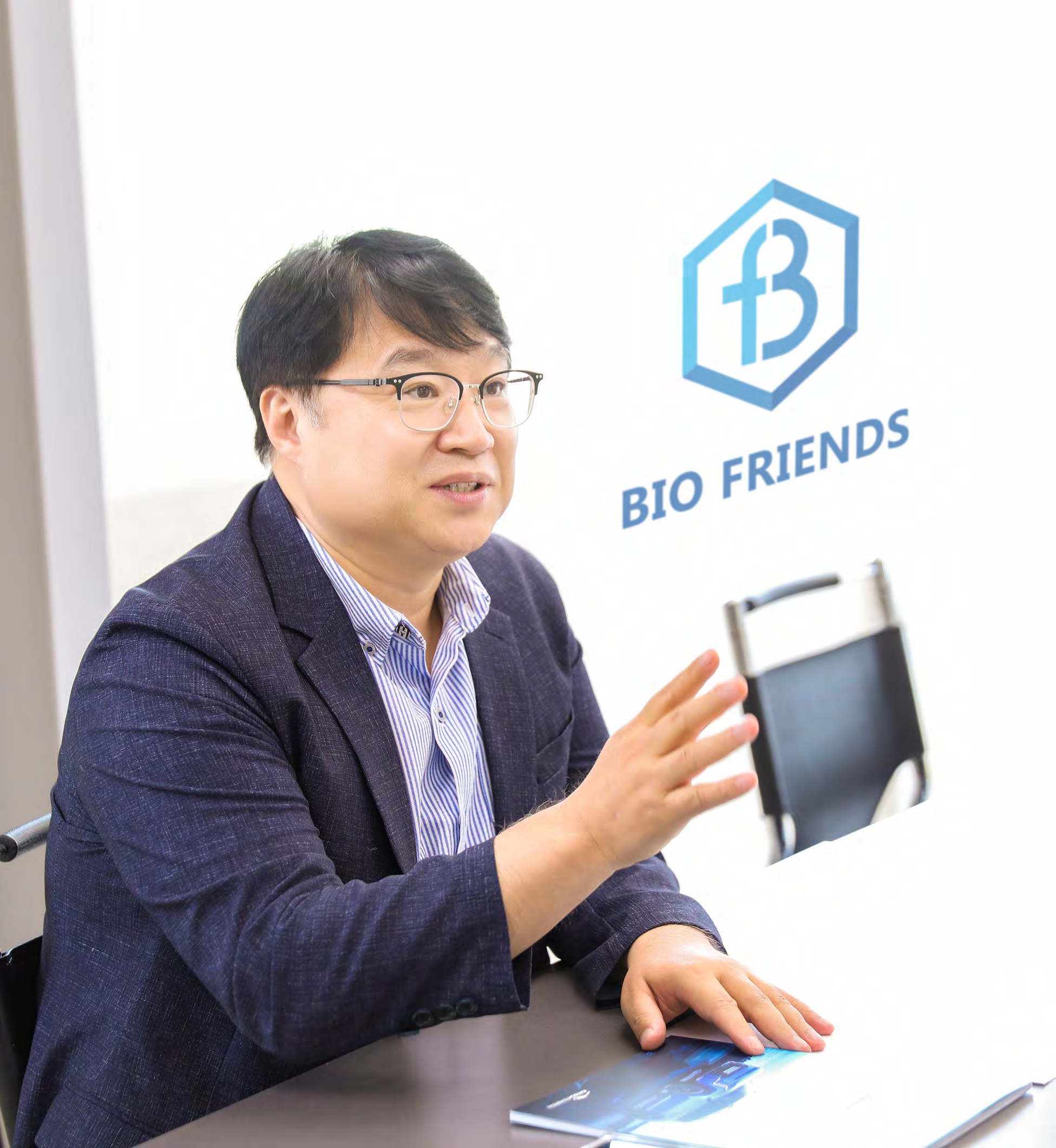
▲Wonjun Cho, CEO of Biofriends Inc., giving an interview
The Korean people are very interested in international oil prices. That is because it has a very large impact on our economy and society. Not only Korea, but even oil-producing countries are never free from international oil prices. But for those of us who have declared 2050 carbon neutral, the oil economy is no longer sustainable. Now, our industry must go beyond economic logic and prepare a new alternative fuel for carbon neutrality. It is for the same reason that interest in e-fuel is increasing recently, especially in developed countries. At Mobility Insight, we met Biofriends, the leader of the domestic DME industry. In the still unfamiliar and nascent domestic eco-friendly energy market, we capture the vision of Green Bioenergy Circulation of Biofriends, which is growing with the vision of the potential of the future energy industry amid difficult conditions of technology development and market development.
If you change your perspective, you can see the future!
Biofriends Inc.
One of the key strategies for carbon neutrality is the development of low-emission alternative fuels. Nevertheless, the development of eco-friendly fuel in Korea is sluggish. To speak more harshly, it can be said that only the necessity and possibility are mentioned around the academic world and research institutes. In this situation, Biofriends, an eco-friendly energy company, is special to us. Despite being a start-up company established in 2016, Biofriends has grown into a leading company representing the domestic dimethyl ether (DME, DiMethyl Ether, hereinafter DME) industry. CEO Wonjun Cho worked for Korea Gas Corporation(KOGAS) for 24 years and succeeded in developing DME direct extraction technology from natural gas as the head of the research and development center after serving as a senior researcher at the time of his tenure. It was high-quality DME with a purity of 99.5%. In addition, the development of catalyst materials necessary for DME extraction and the localization of a container (reactor) containing the catalyst were also successful. Why did CEO Wonjun Cho decide to start a business?
“KOGAS has been researching the DME field for about 14 years since 2000, and at that time, DME attracted attention as a new eco-friendly fuel that can replace diesel because it did not generate fine dust and had a high cetane number. To develop a new fuel, we developed direct extraction technology to overcome the disadvantages of the indirect extraction method, created DME trucks and DME charging stations with the Korea Automobile Research Institute, and planned a DME supply project in collaboration with Korea National University of Transportation.”
However, KOGAS' DME fuel development project lost momentum after 2013.
“International oil prices were the direct reason. Until 2013, international oil prices were strong, maintaining the 0 level, but with the advent of shale gas in the US and China, international oil prices plummeted. As crude oil prices fell, the industry saw no need for new fuels.”
However, CEO Wonjun Cho viewed the value of DME as an alternative fuel differently. I thought that the importance of eco-friendly energy would come to the fore in the near future.
“I retired from KOGAS in 2014 and started my business in 2016. It is not because I have been doing research, but because I am convinced that the time will surely come when eco-friendly alternative fuels such as DME will be recognized in the market rather than economic logic to solve environmental crises such as climate change and greenhouse gases.”
What is DME? A market that is still unknown
The history of the domestic DME industry is short, and the recognition of DME in the market is also low. Biofriends has DME manufacturing technology comparable to the global market, but technology alone was not enough.
"The market was the problem rather than the technology after the start-up. In our industry, DME was originally developed for fuel purposes as a material that was still unfamiliar to us, but even if DME was produced immediately, it was unlikely to enter the fuel market, so we focused on the chemical market that could enter immediately. DME has enough advantages as a chemical product, but if you look at the Global Warming Index (GWP), which represents the warming index, methane is 28 and Freon gas is 1,300-23,900, which is very high, and low LPG for humans is about 3-4. On the other hand, DME's global warming index is 0.3, which is 1/10 less than that of human LPG used for industrial use, so it can greatly reduce its impact on warming. It promotes DME as a replacement for existing petrochemical products and supplies it to industries such as aerosols and eco-friendly refrigerants."
Currently, the domestic DME market size is about 20-30 billion won per year, and Biofriends' market share is around 60%. In the future, Biofriends aims to increase its chemical market share to 80%.
“Currently, the demand of the DME industry in Korea is about 20,000 tons per year. Even if it occupies the entire market, it is too small to challenge the fuel market, making it difficult to secure price competitiveness.”
In order for DME to challenge the fuel market, it must have price competitiveness through production of at least 100,000 tons or hundreds of thousands of tons. The reason Biofriends is trying to increase its share in the existing chemical market is that the size of the DME market is very important.
Blended use of LPG and DME in the automotive industry
Already commercialized in China, preparing for Europe

▲ Green Bio Energy Circulation Structure
Since COVID-19, LPG demand in Europe has continued to grow steadily. This is because LPG has the advantage of being stable in supply and demand from international oil prices and is recognized as an eco-friendly energy source compared to other fossil fuels. In particular, China has been actively promoting the blended use of DME and LPG from an early age.
“DME has an excellent fine dust reduction effect. When blended with LPG used as automobile fuel, carbon emissions can be reduced by at least 35% to as much as 60% compared to conventional pure LPG vehicles. Currently, China ranks first in the blended use market, using about 2.9 million tons of DME per year for fuel as of 2022, and Europe is also actively promoting blended use, such as implementing an incentive policy for the blended use of DME and LPG. Oberon, a company specializing in Suburban propane and DME in the west of the U.S., is also producing blended fuel and supplying it to California. Overseas, the DME and LPG blended fuel market is in its infancy, but it is expected to actively promote it in the future, so there is a need to actively review and promote the use of DME blended fuel in Korea in the future.”
The number of LPG cars in Korea is on the decline, growing to 2.45 million units in 2010 and then decreasing to 2 million units in 2022. In the future, the mixed use of LPG and DME is expected to play a positive role in recovering consumption of LPG vehicles.
“Even if 10% of DME is mixed with an LPG car, it does not affect fuel economy at all. At the same time, carbon emissions are reduced, making it an environmentally superior fuel. Current domestic consumption of LPG is about 10 million tons per year, of which about 2 million tons are used as automobile fuel. Estimating the mixed use ratio of DME and LPG at 10%, a new DME market of about 200,000 tons per year is created, which can be expected to play a significant role in securing global competitiveness by achieving economies of scale in the domestic DME industry.”
As of the end of 2021, LPG cars in Europe account for 72% of the world's LPG cars, and LPG cars are recognized as eco-friendly cars and at the same time enjoy various support policies.
Fossil fuel-based DME meaningless
eDME conversion is future competitiveness
The raw material of DME is methanol. Prior to the foundation, CEO Wonjun Cho, as an engineer, developed Korea's first natural gas DME direct extraction technology and won the Best Technology Award. Nevertheless, CEO Wonjun Cho says that DME must be manufactured through carbon capture in order to secure market competitiveness.
“The vision of our biofriends is to create a new value of carbon reduction through eDME, which is made with our own conversion technology after carbon capture by completing the green bioenergy circulation structure.”
The first button of the circulation structure is carbon capture, which captures carbon dioxide in cement or petrochemical industrial areas with high carbon emissions, thereby supplying carbon, which is the fuel of e-methanol, with carbon reduction effects. Afterwards, eDME is created through Biofriends' conversion technology.
"Since 2021, we have completed a plant that can collect carbon dioxide and produce methanol and DME at a cement industrial complex in Danyang, Chungcheongbuk-do, and are expected to produce about 7,000 tons of methanol annually from 2025. In addition, by 2026, we aim to collect carbon dioxide in Chungcheong and Gangwon areas and produce more than 100,000 tons of eMethanol and 4.5 million tons of eDME using CCU technology."
DME Market Potential Grows Larger in Variously
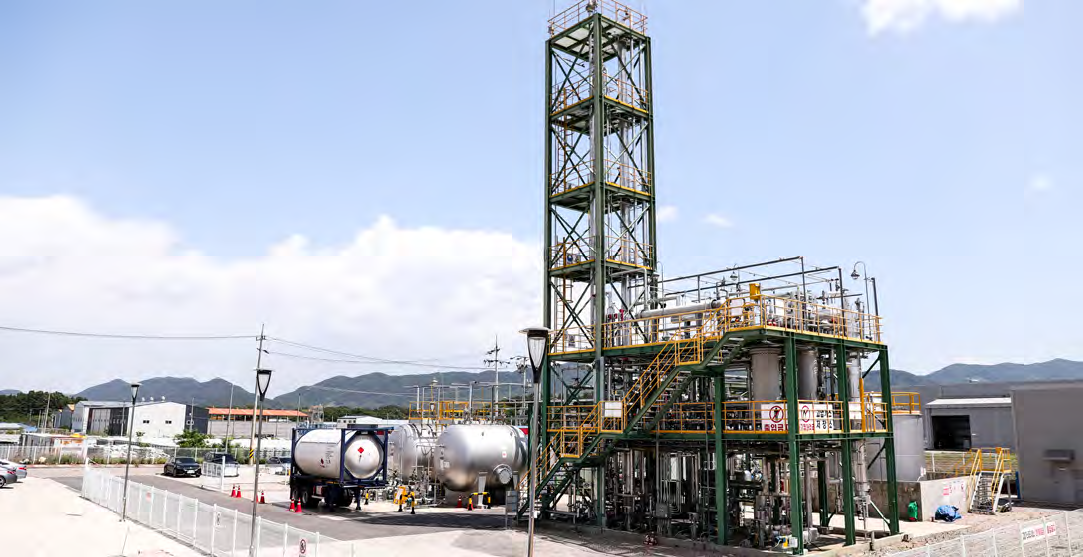
▲ Biofriends Bouen 1st Factory
DME was originally developed as a new alternative fuel. As such, it can be expected to enter the transportation market, heating market, and power generation market as a fuel. We looked at how Biofriends, which is striving to expand the market, is preparing for business in each field.
Carbon neutral blind spot, small ship transportation fuel
Currently exploring the DME market
CEO Wonjun Cho saw the use of DME as a vehicle fuel limited. This is because it is judged that the infrastructure investment cost is too large to use as a new energy source in the automobile market and is inefficient. However, the situation is different when expanding to the transportation sector, especially the ship market, in addition to automobiles.
"With eco-friendly fuel for small ships, DME has sufficient marketability. Electricity is the only way to achieve carbon neutrality, but large ships are developing methanol or ammonia ships through environmental regulations by the International Maritime Organization (IMO), but the situation of small ships is completely different. According to data from the Ministry of Oceans and Fisheries, as of 2021, greenhouse gas emissions in the marine and fisheries sector were 4.061 million tons, of which 3.04 million tons accounted for 70% of the total, but none of the small ships have improved emissions over the past five years since 2017. As policy support focuses only on large ships, it is urgent to improve small ships, which are the main culprits of greenhouse gases."
In order to improve small ships, Biofriends plans to develop eDME ships by 2027 with Target Maritime University through 「Development and Demonstration Project of Low Carbon High Efficiency DME Fuel System for Small Diesel Ships」 from 2023.
“There are about 65,000 coastal and near-sea small ships in Korea, and 27,000 (41%) of them are concentrated in Mokpo and Shinan, Jeollanam-do, so local governments are interested in them. First, if eDME ships are developed and charging stations are installed in coastal areas, greenhouse gas emissions from domestic small ships can be reduced and a new transportation fuel market using DME can be created.”
Competitive enough as an industrial fuel! However, there is no case, and it is difficult to open the market
As of 2021, domestic industrial boilers are about 40,000 to 50,000 units, and it has been investigated that various fuels such as coal, bunker C oil, by-product fuel oil, diesel, LPG, and natural gas are used. Among greenhouse gas emissions by sector, the public electricity and heat production sector accounts for 32.7% of the total emissions. As such, greenhouse gas reduction is urgently needed in the industrial boiler market, and at the same time, it is a promising new market for DME.
“Industrial boilers have an average replacement cycle of about 10 years, so there is a demand for replacement of about 4,000 to 5,000 units per year. Compared to LNG, which is a representative eco-friendly fuel, LPG boilers have excellent price competitiveness, so there is a high demand for replacement of LPG boilers recently. In the industrial LPG boiler market, we can create a new market with our DME and LPG mixed use. As explained earlier, it is possible to reduce carbon emissions by more than 35% without performance problems, but there is no introduction case, so we are still persuading local governments and related government agencies. Although there are already cases of mixed use overseas, it is regrettable that commercialization is difficult because there are no cases of introduction, and I think active policy review is necessary.”
DME met with future agricultural smart farm
Eco-friendliness and economic feasibility expected through distributed power generation
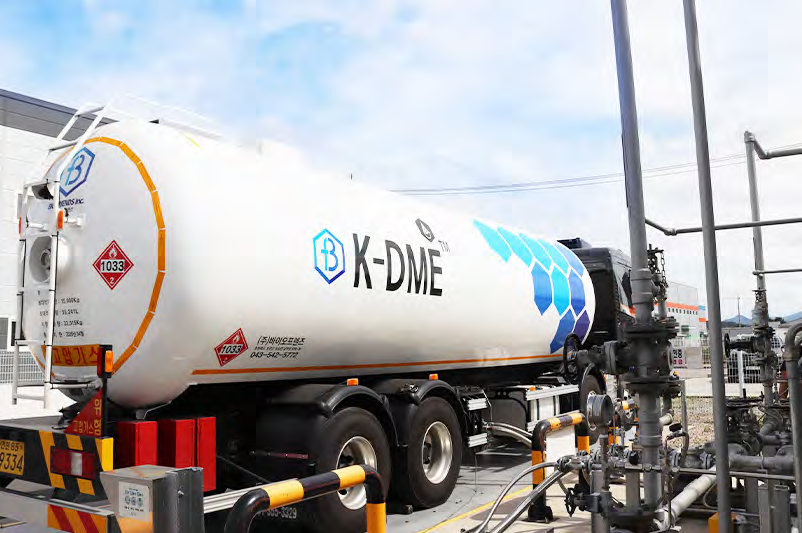
One of the representative fields of Industry 4.0 is Agriculture 4.0, and the scale of smart farms is growing rapidly, mainly in Europe. The Dutch food valley and the Venlo greenhouse called European greenhouse are also leading future agriculture. In Korea, facilities and equipment fields, integrated management systems, irrigation supply facilities, etc. are being introduced for agricultural digitalization.
“Rural areas are receiving government benefits such as tax-free oil and tax-free electricity. Considering the importance of agriculture, a national key industry, this is a necessary policy, but from a carbon-neutral point of view, it is difficult to sustain support for fossil fuels. We set the goal of establishing a new model CO₂ circulating rural village for domestic agriculture and are developing a new circular agriculture through a distributed power generation system and CO₂ capture.”
Currently, there are various boilers for facility farms, but three products that are attracting attention as eco-friendly products are electric boilers, air heat boilers, and geothermal heat boilers. First of all, in the case of electric boilers, the problem of high fuel costs, in the case of air heat, the performance limit at -10 degrees below zero in winter, and in the case of geothermal heat, expensive installation costs are considered as limitations. As a new alternative, Biofriends has developed a DME distributed power generation system, installed it at Canaan Farmers School, and is operating it
“Our DME distributed power generation system uses DME as fuel and supplies the necessary cooling and heating for smart farms or plant factories through independent power generation through two 40kW distributed generators. At first, we conceived of a hydrogen fuel cell as a fuel for a distributed power generation system, but it was difficult to expect price competitiveness of hydrogen, so we developed our own DME fuel cell. The DME distributed power generation system developed by us can be installed for 20 to 30 million won based on a cultivation facility of 500 pyeong, so I think it has excellent performance and economic feasibility.”
The key to carbon utilization is hydrogen!
Turquoise hydrogen is present energy
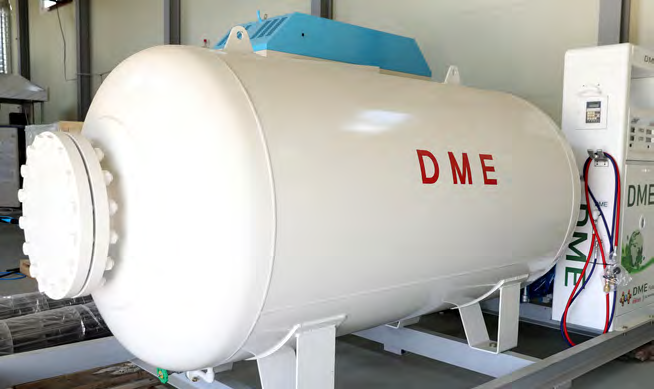
Another major industry of Biofriends is creating a portfolio with the hydrogen production plant business. In 2020, the KOGAS won an order for the Changwon-based hydrogen production base and the Gwangju-based hydrogen production base, with the goal of completing it by 2023.
“We are as serious about the hydrogen industry as DME.” I can feel the affection of CEO Wonjun Cho for the hydrogen business. “CO₂ capture is essential for carbon neutrality, but hydrogen is the key to carbon utilization. Currently, the cost of CO2 capture is between 600 and 1,000 dollars per ton, and carbon capture activities based on landfill do not seem economically feasible. In the end, CCUS can also become a competitive industry when creating an energy circulation structure in which captured CO₂ is combined with hydrogen and reused as e-fuel. The problem is green hydrogen. Personally, I think that hydrogen with economic feasibility and environmental characteristics is blue hydrogen, and we plan to create a hydrogen production business with turquoise hydrogen, one of the blue hydrogen.”
Biofriends has various technologies related to hydrogen production, including steam reforming (SMR) and autothermal reforming (ATR), but CEO Wonjun Cho is focusing on blue-green hydrogen produced with DC plasma technology.
“Turquoise hydrogen is a conversion technology that produces pure hydrogen and electrically conductive carbon black with a 100% environmentally friendly DC process that does not emit CO₂ during the production process. If green hydrogen is an unknown future energy source, I would like to say that blue hydrogen is a current energy source.”
Korea DME Industry Association to fulfill its role as an international cooperation channel
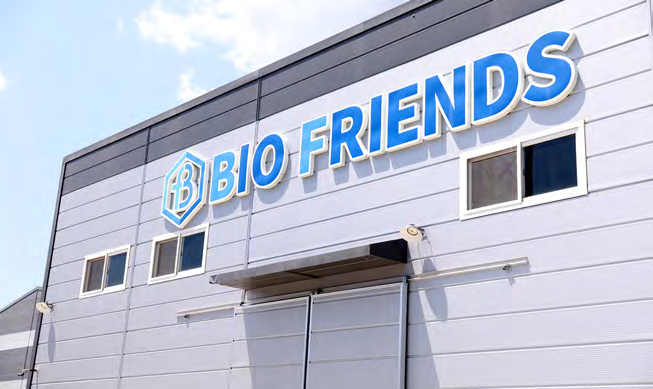
CEO Wonjun Cho has been serving as the chairman of the Korea DME Association since March 2022. We heard about the activities and goals of the Korea DME Association.
"Our Korean DME Association was founded in 2003 and I took office as the 11th president in 2022. Currently, 11 member companies are participating in the association and are active in four divisions: manufacturing facilities, power generation facilities, transportation facilities, and demand development. The association's goal is to create a venue for exchanges between DME industries in various fields and communication between domestic and foreign experts and entrepreneurs through its activities, and to play an active role in inducing local governments and central governments' interest in the DME industry. Finally, we focus on the role of the domestic DME industry as an outpost for growth into a global market. To this end, the first Asia DME Forum was launched in 2004 and the 11th Asia-Pacific DME Forum is being held in 2022. In particular, last year's forum was held for the first time in three years due to COVID-19, and we were able to confirm the high interest of Southeast Asian countries such as Indonesia, Japan, Thailand, and the Philippines in the DME industry. It can be said that the DME market suggests a direction to move forward due to the poor infrastructure construction or natural conditions required for electrification. Through the forum in the future, we would like to strengthen the association to serve as a central point as an international cooperation channel for our DME industry."
With DME and turquoise hydrogen
Growing into a global green bioenergy company
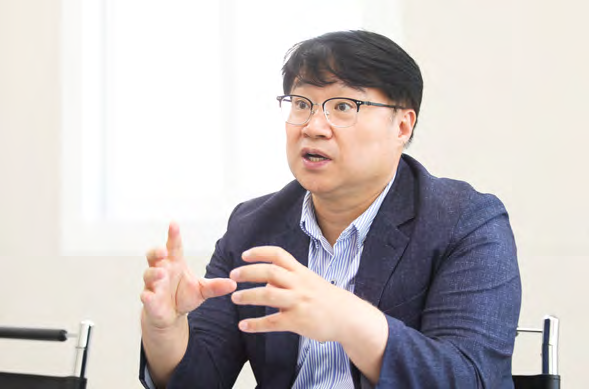
The DME industry is at the level of entering the market both domestically and overseas. This is an opportunity for our DME industry to grow into a leading country in the global market. Especially considering that China, a global manufacturing powerhouse, is nearby, it is important to achieve economies of scale by accelerating growth.
"First of all, I will tell you my business strategy by dividing it into the DME business and the hydrogen industry. DME business strategy is key to achieving economies of scale through market expansion and globalization. Beyond the limited domestic market, the company aims to expand its production scale by expanding its sales outlets to the global market with global production lines by 2027. Currently, even if the domestic DME market is increased to the fuel market to 100,000 tons per year, it is difficult to secure continuous competitiveness on a small scale as an energy business. KOGAS' natural gas scale is 40 million tons per year, and SK Energy's LPG scale is more than 4 million tons per year, and we also think that DME can be competitive as a fuel in the global market only when it grows to at least 1 million tons. To this end, we aim to secure a global manufacturing base through the construction of a DME plant in Indonesia and enter overseas markets such as Europe and the United States in the short term. Second, the hydrogen business wants to be a leader in the blue-green hydrogen production plant business. Since some countries' carbon neutrality target time is 2030, all-round carbon neutrality pressure on all energy sources is expected to be strengthened from 2028. Due to these environmental changes, e-fuel is also expected to form a market from 2030 earlier than expected, and the key is the transition from green hydrogen to blue hydrogen. Blue Hydrogen, including cyanide, is expected to have an opportunity rather than green hydrogen, which is difficult to secure price competitiveness, and through 10 years of growth from 2030 to 2040, we want to grow into a true green bioenergy company contributing to carbon neutrality through a new vision of carbon neutrality by 2050
Last year, Biofriends recorded 14.7 billion won in sales. This is the result of pioneering the market in less than 10 years since its establishment in 2016. But the real growth starts now. As the time towards carbon neutrality approaches, the market will be able to move according to the vision of Biofriends. Lastly, I would like to express my gratitude to CEO Cho Won-joon, who responded to the interview despite his busy schedule, including the completion of the second factory and entry into overseas markets.
Source: Korea Automotive Technology Institute https://www.katech.re.kr


 +82 - 2 - 6739 - 1100~3
+82 - 2 - 6739 - 1100~3 bftech@bfi.co.kr
bftech@bfi.co.kr